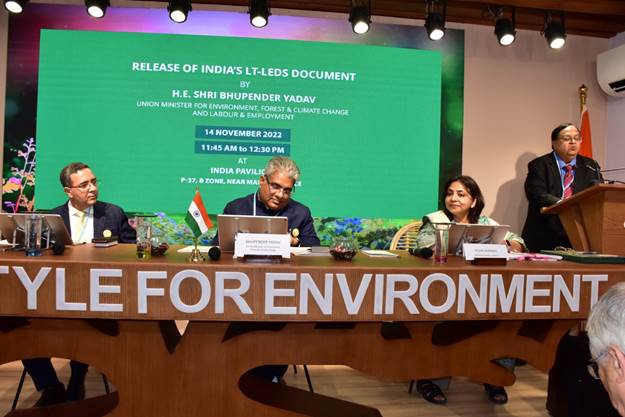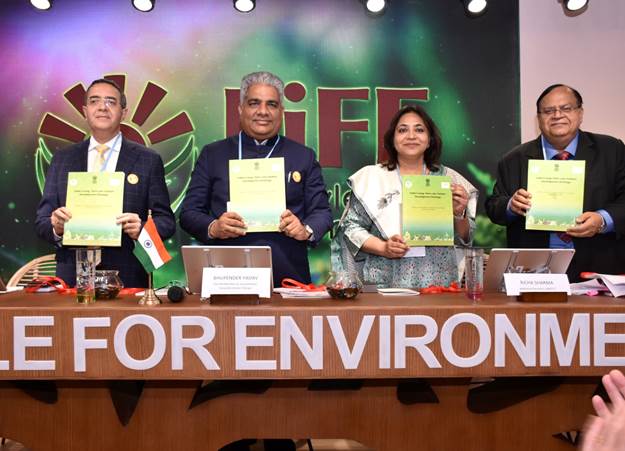Ministry of Environment, Forest and Climate Change

India Submits its Long-Term Low Emission Development Strategy to UNFCCC
With this release, India joins the select list of less than 60 parties that have submitted their LT LEDS to UNFCCC.
Posted On: 14 NOV 2022 4:46PM by PIB Delhi
India submitted its Long-Term Low Emission Development Strategy to the United Nations Framework Convention on Climate Change (UNFCCC), during the 27th Conference of Parties (COP27) today. The Long-Term Low Emission Development Strategy was launched by the Union Minister for Environment, Forest and Climate Change, Shri Bhupender Yadav, who is leading the Indian delegation to COP 27, being held at Sharm-el-Sheikh, Egypt from 6-18 November, 2022.

The salient features of the strategy are –
- The focus will be on the rational utilization of national resources with due regard to energy security. The transitions from fossil fuels will be undertaken in a just, smooth, sustainable and all-inclusive manner.
The National Hydrogen Mission launched in 2021 aims to make India a green hydrogen hub. The rapid expansion of green hydrogen production, increasing electrolyser manufacturing capacity in the country, and three-fold increase in nuclear capacity by 2032 are some of the other milestones that are envisaged alongside overall development of the power sector.
- Increased use of biofuels, especially ethanol blending in petrol, the drive to increase electric vehicle penetration, and the increased use of green hydrogen fuel are expected to drive the low carbon development of the transport sector. India aspires to maximise the use of electric vehicles, ethanol blending to reach 20% by 2025, and a strong modal shift to public transport for passenger and freight.
- While urbanisation will continue as a strong trend from our current relatively low base, future sustainable and climate resilient urban development will be driven by smart city initiatives, integrated planning of cities for mainstreaming adaptation and enhancing energy and resource efficiency, effective green building codes and rapid developments in innovative solid and liquid waste management.
- India’s industrial sector will continue on a strong growth path, in the perspective of ‘Aatmanirbhar Bharat’ and ‘Make in India’. Low carbon development transitions in the sector should not impact energy security, energy access and employment. The focus will be on improving energy efficiency by the Perform, Achieve and Trade (PAT) scheme, National Hydrogen Mission, high level of electrification in all relevant processes and activities, enhancing material efficiency and recycling leading to expansion of circular economy, and exploring options for hard-to-abate sectors, such as steel, cement, aluminium and others.
- India has a strong record of enhancing forest and tree cover in the last three decades alongside high economic growth. India’s forest fire incidence is well below global levels, while its forest and tree cover are a net sink absorbing 15% of CO2 emissions in 2016. India is on track to fulfilling its NDC commitment of 2.5 to 3 billion tonnes of additional carbon sequestration in forest and tree cover by 2030.
- The transition to low carbon development pathway will entail several costs pertaining to the development of new technologies, new infrastructure, and other transaction costs. While several estimates exist, varying across studies, they all fall generally in the range of trillions of dollars by 2050. Provision of climate finance by developed countries will play a very significant role and needs to be considerably enhanced, in the form of grants and concessional loans, ensuring scale, scope and speed, predominantly from public sources, in accordance with the principles of the UNFCCC.

The Paris Agreement in Article 4, paragraph 19, states, “All Parties should strive to formulate and communicate long-term low greenhouse gas emission development strategies, mindful of Article 2 taking into account their common but differentiated responsibilities and respective capabilities, in the light of different national circumstances.”
Further, COP 26 at Glasgow in November 2021, in Decision 1/CP.26, inter alia, (i) urged Parties that have not yet done so to communicate their LT-LEDS by COP 27 (November 2022).
The document has been prepared after extensive consultations held by Ministry of Environment, Forest and Climate Change with all relevant Ministries and Departments, State Governments, research institutions, and civil society organisations.
India’s approach is based on the following four key considerations that underpin its long-term low-carbon development strategy:
- India has contributed little to global warming, its historical contribution to cumulative global GHG emissions being minuscule despite having a share of ~17% of the world’s population.
- India has significant energy needs for development.
- India is committed to pursuing low-carbon strategies for development and is actively pursuing them, as per national circumstances
- India needs to build climate resilience.
The two themes of “climate justice” and “sustainable lifestyles”, alongside the principles of Equity and Common But Differentiated Responsibilities and Respective Capabilities (CBDR-RC), in the light of national circumstances, that India had emphasized at Paris, are at the heart of a low-carbon, low-emissions future.
Similarly, the LT-LEDS has been prepared in the framework of India’s right to an equitable and fair share of the global carbon budget, which is the practical implementation of India’s call for “climate justice.” This is essential to ensure that there are no constraints on realizing India’s vision of rapid growth and economic transformation, while protecting the environment.
The LT-LEDS is also informed by the vision of LiFE, Lifestyle for the Environment, that calls for a world-wide paradigm shift from mindless and destructive consumption to mindful and deliberate utilization.
For Text of Union Minister’s speech at the Launch click here.
*****
HS/SSV
(Release ID: 1875816) Visitor Counter : 426




















